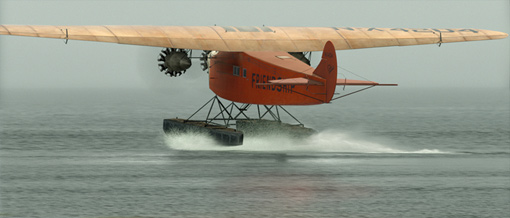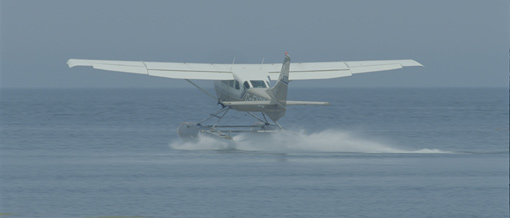Nothing Flashy as Mr. X Recreates Period Planes and Settings for Earhart Biopic
Amelia is director Mira Nair’s new biopic retelling the story of aviation pioneer Amelia Earhart, who disappeared over the Pacific in an attempted around-the-world solo flight. Toronto’s Mr. X delivered 277 shots that not only helped put Earhart – played here by Hillary Swank – in the air, but helped maintain the necessary illusion of a period piece. VFX supervisor Wojciech Zielinski was charged with executing photorealistic CG that didn’t call attention to itself, including the creation of cloudscapes and flight scenes. Film & Video spoke with Zielinski about the work that went into the film’s CG environments, crowd duplication and set augmentation as well as CG aircraft and a critical crash sequence.
WOJCIECH ZIELINSKI: The director, Mira Nair, treated the subject as more of a love story than a classical biography. But the aviation component is, obviously, very strong. That was her life and her passion, and that’s exactly where there was a need for VFX. Together with the art department, we had to find out what kind of airplanes she flew, and based on those drawings we built assets that were animated and used in the shots. At the same time, the art department was building real replicas of those airplanes.
How did you do that research? Did you approach the original manufacturers for specific information about how the planes were contributed?
It’s really hard to find proper information about those old airplanes. Usually the manufacturers are not really interested in helping out. They’re struggling with their own businesses and can’t dedicate any resources. But there are many people treating aviation as a hobby, and these people are usually willing to help us. But personally, we didn’t have to find the blueprints. That was tackled by the art department, and we work as a team.
There were three airplanes used in the movie. One was the Fokker [F.VIIb] “Friendship,” the plane in which she crossed the Atlantic for the first time. However, she didn’t fly as a pilot but as a captain who was in charge of the two pilots. Then there was the Lockheed Vega [5b]. And the third airplane, the most iconic, is the Lockheed [L-10E] Electra. The art department built life-size replicas of the Friendship and the Vega, but those replicas couldn’t fly. They could tow them on the ground, and the Friendship was a sea plane that could be towed on the water, but they couldn’t use it in an aerial shot or sequence. Therefore we had to build digital assets based on those, and later on in post we had to design the shot and the environment and animate those airplanes.
Were your shots mostly all CG or composited with live-action footage?
The majority of those shots are all CG. With the Fokker Friendship, we have plenty of shots of the airplane taking off from water. Because the life-size replica couldn’t fly, we had to come up with a solution of how to pull it off. We decided to film a real flying airplane – a Cessna seaplane – taking off and landing in the water, just to get the proper water elements. In post, we painted out the airplane, animated our CG airplane accordingly, and then added it to the plate. And we had to enhance it with CG spray.

Mouseover film still above to compare to original live-action plate
What software tools were you using?
We used Maya for modeling. Geometry is built in Maya, and then we’re doing texturing and shading, lighting, and rendering in Houdini.
What was the biggest challenge on this film?
The most difficult sequence for us was the aerial sequence with the Lockheed Vega. We not only had to create the airplane but also the environment. In the story, she takes off from Teterboro Airport and flies toward Europe. She’s approaching a heavy storm front, and obviously it was impossible to schedule a proper storm to film as a background plate. We knew right away that we would have to create cloudscapes for this sequence. The part in which she flies through the storm is entirely digital – digital clouds, digital rain, digital lightning.
And how did you create those individual elements?
The lightning was created in compositing, but the clouds were done using our proprietary volumetric tools based on Houdini. The rain is a little bit of 3D and a little bit of 2D. There’s no single formula. You have to evaluate your element list on a shot-by-shot basis. Some shots require extreme-foreground elements like rain, but it’s much more efficient to use a 2D rain element instead of generating ran for each shot.
What about shots from inside the cockpit? Was that basic green-screen work?
Yes, but at the same time we had to create those environments for the backgrounds. There are a few shots with the Friendship for which we shot aerial plates as a background, but this one required CG environments.
Were those the most complex shots?
Yes, the Vega flight and the Friendship take-off and landing. The third one was the Electra crash. She starts rolling the airplane, and the right landing gear breaks. The right wing hits the runway, and after that the left landing gear breaks down and the plane slides on its belly. It was quite tricky. We used a vintage airplane, but we couldn’t crash it. Production came up with an articulated crash rig. We removed it in post and added a few elements and some CG enhancement so it does look like a real crash. It was quite challenging, just because the rig was really massive. We had to be quite creative to make sure everything looked correct, and it didn’t feel like the airplane was too high or too low.
Did you also create VFX to maintain the period atmosphere?
There were certain scenes, like a ticker-tape parade, in which we had to do crowd replication. The parade should take place on Broadway [in New York City], but it was shot here [in Toronto] and we had to make sure it looked like Broadway. We found a suitable location that had period-correct buildings, and the rest is set extensions. I was on set supervising the shots that required visual effects, but quite often they called us and said, “We have a beautiful location but certain elements are not period-correct. Can you help us here?” What’s interesting is that the first request from Mira Nair was to make sure that the effects would be invisible. She wants the audience to be able to focus on the story, and she wanted to make sure we would not come up with any sort of flashy effects. This is a period piece, not a movie driven by visual effects. They’re supposed to be as subtle as possible.
Did you enjoy this article? Sign up to receive the StudioDaily Fix eletter containing the latest stories, including news, videos, interviews, reviews and more.











Leave a Reply